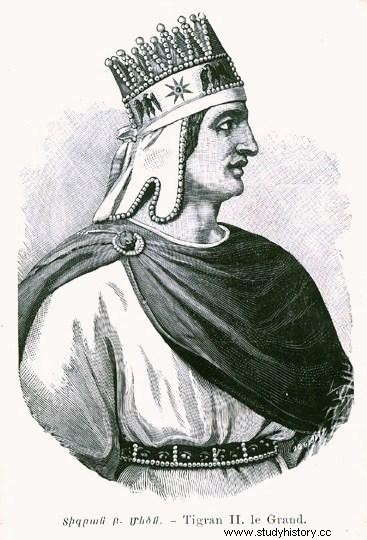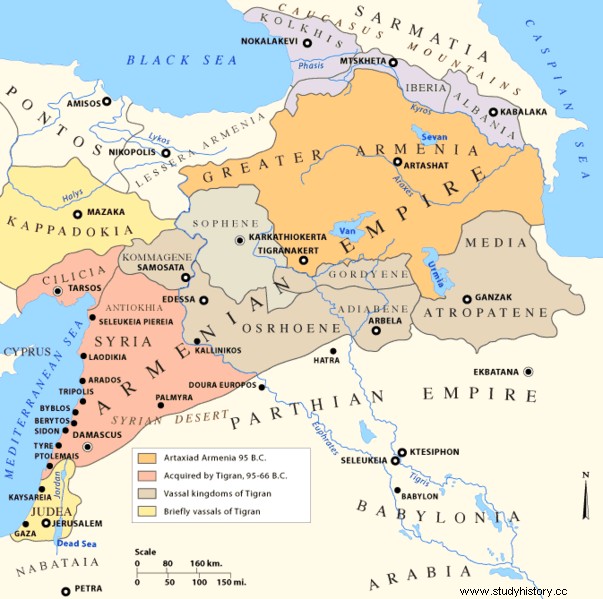Our archenemy today is a secondary of the History of the Roman East. Other more important or influential characters in his environment diminished his prominence. Tigranes II (Tigran Mets in Eastern Armenian, Dikram Metz listen)) was king of Armenia from 95 to 55 BC. There is no consensus on whether his father was Tigranes I or Artavasdes I.

Tigranes II
Tigers He was the most prominent king of the Artaxid dynasty, founded by King Artaxias in 189 BC. when, after the battle of Magnesia, Rome defeated Antiochus (archenemy that we have already seen) and Armenia was freed from the Seleucid yoke. He spent his childhood as a hostage of Mithridates II of Parthia. When his father died, Tigranes bought his freedom from the Parthian king by seventy valleys in Media Atropatene (today Iranian Azerbaijan). He was then forty years old.
His first provision as king of Armenia was to eliminate the noble power in the so-called nakharar , valleys between mountains, as well as as many suitors as could hinder his career. As the kingdom grew stronger, its neighboring nation was in a position to challenge Rome itself. To strengthen ties with the kingdom of Pontus, Tigranes married Cleopatra, daughter of Mithridates VI Eupator , one of the most declared enemies of Rome throughout its history.
The pact with Mithridates left his mother-in-law free rein in Asian affairs, counting on his support to expand Armenia into Syria and Parthia. When the First Mithridatic War broke out with the invasion of Bititnia, Tigranes supported his father-in-law, but did not get involved (it was around these dates that, by decree of Mithridates, the great massacre of Roman citizens throughout Asia took place that caused the forceful response of Rome:the sending of Lucius Cornelius Sulla and his legions)
With his mother-in-law roaming freely throughout Asia, in 88 B.C. Tigranes saw the opportunity to take revenge on Parthia, beheaded after the king's death and a violent incursion by the Scythians (Iranian horsemen). The ease with which he carried out the Parthian campaign gave him wings to complete his expansionist project and invade Syria. The pretext was the Seleucid succession dispute. One of the factions requested the Armenian mediation and the armies of Tigranes reached Judea. That was the moment of its greatest expansion, from the Jordan to the Euphrates, and from the Caspian to the Mediterranean, the kingdom of Armenia had become a state of reference in the East.
During the following years, Tigranes dedicated himself to consolidating his power over such vast territories, raising a new capital for his kingdom, Tigranocerta , and he populated it with Armenians and other deported peoples. As a counterpoint to such a bonanza, things were not going so well for his father-in-law Mithridates of Pontus. Nicomedes of Bithynia he had recovered the kingdom from him with the help of Rome, creating such strong ties with his protectors that in his will he gave the kingdom to the Republic. The gossips spoke of a torrid love affair between King Nicomedes and Rome's envoy, a certain Gaius Julius Caesar. The latter's detractors called her “The Queen of Bithynia ”And his soldiers sang “Caesar subdued Gaul and Nicomedes subdued Caesar ”. The fact is that, since Sulla forced Mithridates to sign an armistice in 85 BC, things had gone from bad to worse for the lion of Pontus.
In 74 BC the Third Mithridatic War broke out . After a succession of operations in Pontus orchestrated by the consul Lucius Licinius Lucullus , Mithridates fled from his kingdom and sought refuge at the court of his son-in-law. Tigranes felt strong, unbeatable after the victorious campaigns in Parthia and Syria. Lucullus formally requested the delivery of Mitrídates, but the Armenian refused the Roman proposal. This fact led to the battle of Tigranocerta

Armenian Empire of Tigranes
On October 6, 69 B.C. Lucullus's legions arrived before the walls of the Armenian capital after neutralizing a surprise attack led by Mithrobarzanes, one of the most trusted Armenian generals. Faced with such a failure, and fearful that Lucullus would besiege the city, Tigranes drew the entire enormous army from him and arranged it in battle order on a hill on the south bank of the river, southwest of the city. Learning of the Roman's scarcity of troops, he is credited with this mocking comment:"they are too few for an army, but too many for an embassy ”
The battle line was configured in three large blocks led by Tigranes himself in the center at the head of the cataphracts (Persian-style heavy cavalry) and two vassal kings on his flanks.
Lucullus, with two legions and two thousand auxiliaries against a force perhaps exceeding two hundred thousand men, ignoring his tribunes who advised him not to fight, mobilized the light infantry, forded the river and sent the Gallic and Thracian auxiliary horsemen to attack. distract the flanks. The shapeless mass of the Armenian army was unable to react to the double lateral charge of the Roman cavalry seconded by the advance of the cohorts commanded by Lucullus towards the center. The cataphracts As they fled, the shaky Armenian line broke at several points and a bloodbath ensued that Roman historians are sure to have magnified.
Plutarch commented that Lucullus, upon gaining the hill, exclaimed "The day is ours, the day is ours, my fellow soldiers ”. The casualty count is probably the result of Roman propaganda, but, according to Plutarch, Lucullus lost five men that day and had a hundred wounded, compared to more than a hundred thousand Armenians killed or taken captive.
In the absence of the king, he disappeared After the battle, the guards opened the gates of the city and Lucullus added a rich booty to his great victory. Tigranes sent six thousand horsemen to his city to try to save as much as he could from the clutches of the Romans. Lucullus failed to take advantage of success. His great victory only masked reality:Mithridates and Tigranes had fled and would soon be able to fight again, as it was only a year later at the battle of Artaxata, the ancient capital in the heart of the Armenian mountains. It was a Pyrrhic victory for the Roman, as he suffered so many casualties and generated so much discontent among his own that the troops mutinied against him up to three times. The senate had to send their best man, Pompey the Great, to replace him and end hostilities.
When Pompey arrived in Armenia in 66 BC, Tigranes was already seventy-five years old (extreme longevity when life expectancy was around forty). Perhaps his advanced age, or the sanity that it imprints, made him agree with the Roman. Six thousand talents of silver and the delivery of her son as a hostage were the price of her freedom; he continued to rule Armenia as a friend and ally of the people of Rome, an honorary title he held until his death in 55 BC.
